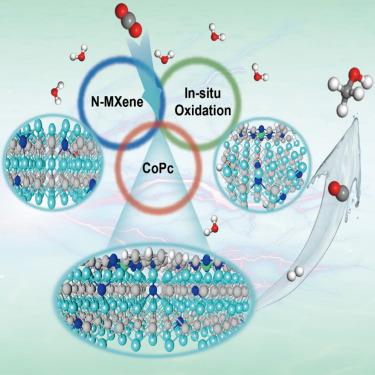当前位置:
X-MOL 学术
›
Chem Catal.
›
论文详情
Our official English website, www.x-mol.net, welcomes your feedback! (Note: you will need to create a separate account there.)
Highly effective electroreduction of carbon dioxide to methanol with molecular catalysts restricted on N–MXene for electronic regulation of CoPc
Chem Catalysis ( IF 11.5 ) Pub Date : 2024-06-04 , DOI: 10.1016/j.checat.2024.101014 Bihua Hu , Bingxian Chu , Hailin Cao , Zhiwei Lei , Shuyu Cui , Peizhi Wang , Jun Tang , Xingzhu Wang , Baomin Xu
Chem Catalysis ( IF 11.5 ) Pub Date : 2024-06-04 , DOI: 10.1016/j.checat.2024.101014 Bihua Hu , Bingxian Chu , Hailin Cao , Zhiwei Lei , Shuyu Cui , Peizhi Wang , Jun Tang , Xingzhu Wang , Baomin Xu

|
Molecular catalysts with precisely designed structures and abundant metal-nitrogen active sites have garnered significant attention for their ability to efficiently perform electroreduction of carbon dioxide (ERCD). However, the catalytic efficiency and selectivity are significantly limited by the fixed electronic structure of the metal-nitrogen structure, resulting in low production efficiency of more valuable products. This work presents the electronic regulation of cobalt phthalocyanine (CoPc) through oxidation of N-doped TiCT nanosheets (CoPc/o–N–MXene). The resulting material exhibits high activity and tailorable selectivity. The study confirmed a strong interaction between Co-N active sites and N–MXene after oxidation, resulting in a “Co–N–MXene” bond. This bond contributes to the transformation of intermediate CO into HCO, leading to a high selectivity of ERCD to methanol. This work provides a perspective on the mechanism of ERCD to methanol and an avenue for the synthesis of effective catalysts.
中文翻译:

利用限制在 N-MXene 上的分子催化剂将二氧化碳高效电还原为甲醇,以实现 CoPc 的电子调节
具有精确设计的结构和丰富的金属氮活性位点的分子催化剂因其有效进行二氧化碳电还原(ERCD)的能力而受到广泛关注。然而,催化效率和选择性受到金属-氮结构的固定电子结构的显着限制,导致更有价值的产品的生产效率较低。这项工作提出了通过 N 掺杂 TiCT 纳米片 (CoPc/o-N-MXene) 的氧化对钴酞菁 (CoPc) 的电子调节。所得材料表现出高活性和可定制的选择性。研究证实氧化后 Co-N 活性位点与 N-MXene 之间存在强烈相互作用,形成“Co-N-MXene”键。该键有助于中间体 CO 转化为 HCO,从而使 ERCD 对甲醇具有高选择性。这项工作为 ERCD 合成甲醇的机理提供了视角,并为合成有效催化剂提供了途径。
更新日期:2024-06-04
中文翻译:

利用限制在 N-MXene 上的分子催化剂将二氧化碳高效电还原为甲醇,以实现 CoPc 的电子调节
具有精确设计的结构和丰富的金属氮活性位点的分子催化剂因其有效进行二氧化碳电还原(ERCD)的能力而受到广泛关注。然而,催化效率和选择性受到金属-氮结构的固定电子结构的显着限制,导致更有价值的产品的生产效率较低。这项工作提出了通过 N 掺杂 TiCT 纳米片 (CoPc/o-N-MXene) 的氧化对钴酞菁 (CoPc) 的电子调节。所得材料表现出高活性和可定制的选择性。研究证实氧化后 Co-N 活性位点与 N-MXene 之间存在强烈相互作用,形成“Co-N-MXene”键。该键有助于中间体 CO 转化为 HCO,从而使 ERCD 对甲醇具有高选择性。这项工作为 ERCD 合成甲醇的机理提供了视角,并为合成有效催化剂提供了途径。






































 京公网安备 11010802027423号
京公网安备 11010802027423号